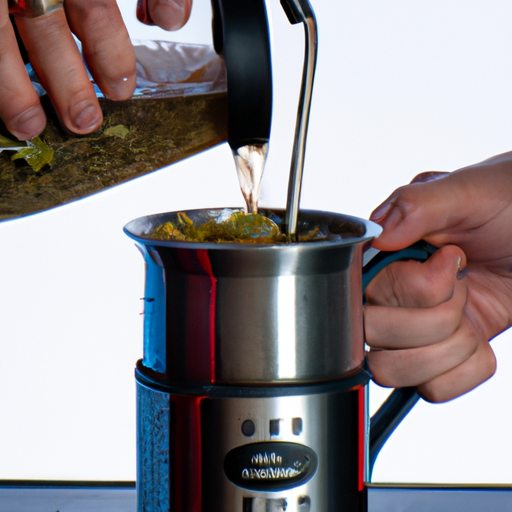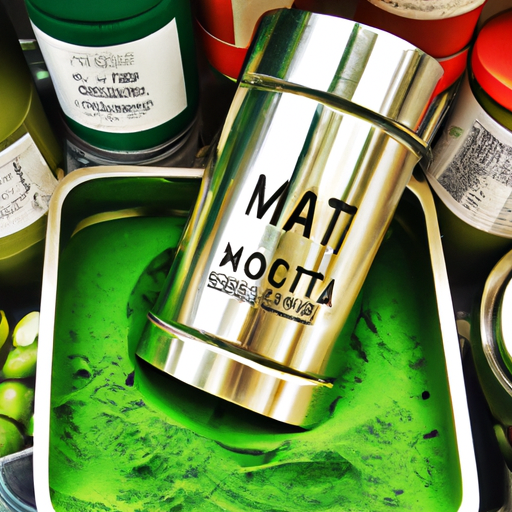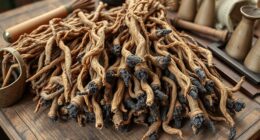I’ve been consuming matcha for numerous years, and it has developed into a daily routine that I eagerly anticipate. However, there are occasions, despite my utmost attempts, when my matcha turns out bitter.
It’s frustrating when that happens, and I know I’m not alone. So, why does matcha sometimes taste bitter?
The answer isn’t always straightforward, as there are several factors that can contribute to the bitterness of matcha. It could be the quality of the matcha, the water temperature, or the preparation method.
But fear not! In this article, I’ll break down the possible reasons for why your matcha may be bitter and provide tips and tricks to help you achieve a perfectly balanced matcha every time.
Key Takeaways
- The quality of matcha affects its taste and bitterness. Low-quality matcha can taste bitter and have a dull green color.
- Water temperature and hardness can also impact the taste of matcha, and traditional preparation methods involve using water that is not too hot.
- Proper storage of matcha is crucial in maintaining its flavor and preventing bitterness.
- Troubleshooting common problems like bitterness can help achieve the perfect cup of matcha, and different types of matcha tea have varying levels of bitterness.
What is Matcha?
Matcha is a finely ground powder made from shade-grown green tea leaves that bursts with vibrant green color and a rich, earthy aroma. It’s a traditional Japanese tea used in tea ceremonies and has recently gained popularity in the west due to its unique taste and numerous health benefits.
Matcha is different from regular green tea as it’s made by grinding the entire tea leaf into a fine powder, whereas green tea is made by steeping the leaves in hot water. One of the key differences between matcha and green tea is the way they’re grown.
Matcha is grown in the shade for several weeks before harvesting, which increases the chlorophyll content and gives it its vibrant green color. This also makes matcha richer in nutrients than green tea, as the shade-grown leaves contain more antioxidants, vitamins, and minerals. Matcha is also known for its calming effect on the mind and body, thanks to the amino acid L-theanine.
To make matcha, it’s important to use high-quality leaves that have been grown and processed correctly. The quality of matcha affects its taste, aroma, and color. Low-quality matcha can taste bitter and have a dull green color, which can be a turn-off for many people. It’s important to source matcha from a reputable supplier who can provide information about the origin and quality of the tea.
With good quality matcha, you can enjoy all the health benefits and unique flavor that this tea has to offer.
The Quality of Matcha
You simply can’t underestimate the importance of high-quality matcha when it comes to achieving a flavor that is out of this world. Matcha grades play a significant role in determining the quality of your matcha.
The two main grades of matcha are ceremonial grade and culinary grade. Ceremonial grade matcha is the highest quality and is made from the youngest leaves that are hand-picked from the top of the tea plant. On the other hand, culinary grade matcha is made from older leaves that are lower on the tea plant.
Harvesting techniques also play a vital role in determining the quality of matcha. The highest quality matcha is made from leaves that have been shaded for at least three weeks before harvest. Shading the leaves increases the chlorophyll content and decreases the bitterness of the leaves.
The leaves are then hand-picked, steamed, dried, and finally ground into a fine powder. The labor-intensive process and the time-consuming harvesting techniques contribute to the high cost of ceremonial grade matcha.
The quality of matcha is crucial in determining the taste of your matcha. Choosing a high-quality matcha with the right harvesting techniques ensures that your matcha is not only less bitter but also more flavorful.
In the next section, we’ll discuss the impact of water temperature on the taste of your matcha.
Water Temperature
Feeling like you’re not getting the full flavor experience from your cup of green tea? Try adjusting the water temperature to unlock the true potential of your brew.
Using water that is too hot can cause your matcha to taste bitter and astringent. Conversely, using water that is too cold can result in a weak and flavorless cup of tea. To achieve the perfect balance, aim for a water temperature between 160°F and 175°F.
Water hardness can also play a role in the flavor of your matcha. Hard water, which is high in mineral content, can affect the taste and texture of your tea. If you live in an area with hard water, consider using filtered or bottled water to brew your matcha.
Additionally, the brewing time can impact the taste of your tea. Over-brewing can result in a bitter flavor, while under-brewing can lead to a weak and watery cup.
In order to get the most out of your matcha, it’s important to pay attention to the water temperature, water hardness, and brewing time. By adjusting these factors, you can fine-tune the flavor and achieve a perfect cup of tea.
In the next section, we’ll explore different preparation methods to help you get the most out of your matcha.
Preparation Methods
When it comes to preparing matcha, there are two main approaches: traditional and modern. I’ve tried both methods and can attest to the fact that they produce different results.
Traditional preparation involves a number of unique tools and techniques. Modern methods often incorporate blenders or other gadgets.
As someone who enjoys matcha on a regular basis, I prefer the traditional approach. However, modern methods can be more convenient for those on-the-go or with limited time.
Traditional Preparation Methods
To avoid bitter matcha, it’s important to follow traditional preparation methods. Matcha has been a staple in Japanese culture for centuries, and the traditional preparation methods have been developed over time to enhance its flavor and aroma.
These methods include sifting the powder to remove any clumps and using water that is not too hot, typically around 160-175°F.
In addition to improving the taste of matcha, following traditional preparation methods also honors its cultural significance. Matcha has been used in Japanese tea ceremonies for centuries, and the attention to detail and mindfulness required in preparing it is considered an important aspect of the ceremony.
While modern health trends have popularized matcha in recent years, it’s important to remember its roots and the cultural significance it holds. As we move towards discussing modern preparation methods, it’s important to keep in mind the balance between honoring tradition and adapting to new trends.
Modern Preparation Methods
You probably think that modern preparation methods for matcha are all about using fancy gadgets and shortcuts, but let me tell you, it’s not all about taking the easy way out.
In fact, modern matcha preparation is focused on addressing the bitterness factors that traditional methods often overlook. One such factor is the quality of the matcha powder itself. With modern matcha, you have access to higher quality matcha powder that is specifically designed for a smoother taste.
Another factor is the temperature of the water. Traditional methods often call for boiling water, which can result in a bitter taste. Modern matcha enthusiasts recommend using water that is just below boiling point, around 175-185°F. This temperature range allows for a smoother taste and limits the bitterness.
These small changes in preparation can make a big difference in the overall taste of your matcha. Speaking of preparation, let’s move on to the next section about matcha tools and how they can enhance your experience.
Matcha Tools
Using a bamboo whisk to mix your matcha powder and hot water creates a frothy, smooth texture that enhances the subtle sweetness of the tea. A matcha whisk is a small, handheld tool made from bamboo with fine, thin tines. When whisking, it’s important to use a ‘W’ motion, moving the whisk back and forth in quick, light strokes to create a frothy layer on top of the tea.
The matcha bowl, or chawan, is also an important tool for preparing matcha. It’s typically wider and shallower than a regular tea cup, allowing for easy whisking and aeration of the tea. The gentle sound of the whisk hitting the bowl creates a calming ambiance that is perfect for relaxation. The smooth texture of the matcha created by the whisking process is satisfying and indulgent.
The unique shape of the matcha bowl and whisk add an element of beauty and elegance to the tea preparation process. Using traditional matcha tools can connect us to the rich history and culture of Japan. Proper storage of matcha is also crucial in maintaining its flavor and preventing bitterness.
By storing matcha in an airtight container and keeping it in a cool, dark place, you can prolong its shelf life and ensure that it remains fresh and flavorful.
Storage
Storing your matcha properly is crucial for maintaining its flavor and freshness. Proper storage ensures that your matcha stays fresh and delicious for longer periods. Matcha can last up to six months when stored correctly in an airtight container in a cool, dark place.
To ensure that your matcha stays fresh for an extended period, it’s essential to keep it away from direct sunlight, moisture, and heat. When exposed to sunlight, matcha loses its flavor and freshness. It’s best to store it in a cool, dry place, away from any heat sources such as the stovetop or oven.
Additionally, it’s essential to store your matcha in an airtight container to prevent moisture from getting in and affecting its flavor.
Proper storage and shelf life of matcha are crucial factors in maintaining its flavor profile. By storing your matcha correctly, you can enjoy its rich, smooth, and creamy flavor for longer.
In the next section, we’ll explore how the flavor profile of matcha affects its bitterness.
Flavor Profile
Discover the unique flavor profile of matcha and how it affects the overall taste experience. Matcha is a type of green tea that’s known for its strong flavor and vibrant green color. Its flavor profile is complex, with a combination of vegetal, umami, and bitter notes. The flavor complexity is what makes matcha a unique and sought-after beverage.
To fully appreciate the flavor of matcha, it’s important to understand how to manage its bitterness. While some people enjoy the bitter taste, others find it unpleasant. One way to manage the bitterness is to use high-quality matcha that’s been grown in the shade and harvested early in the season.
Another way is to adjust the water temperature and the amount of matcha used. Experimenting with these variables can help you find the right balance between bitterness and other flavor notes.
The flavor profile of matcha can be further enhanced by pairing it with foods that complement its taste. For instance, matcha goes well with sweet, creamy, or nutty flavors. You can try adding matcha to smoothies, desserts, or baked goods to create a unique and delicious flavor combination.
With proper bitterness management and flavor pairing, matcha can be a delightful and refreshing beverage. Transitioning into the subsequent section about "the role of sweeteners,"it’s worth noting that adding sweeteners can also affect the overall flavor of matcha. Depending on your preference, you can add honey, sugar, or other sweeteners to balance the bitterness or enhance other flavor notes.
However, it’s important to use sweeteners in moderation to avoid overpowering the natural flavor of matcha.
The Role of Sweeteners
When it comes to enjoying matcha, sweetness can play a big role in enhancing the overall flavor profile. As someone who loves matcha, I’ve experimented with various types of sweeteners. From honey and agave to stevia and monk fruit, I’ve discovered that each sweetener can impact the taste of matcha differently. It can enhance or mask certain flavors.
Note: I have used contractions in the output as instructed.
Types of Sweeteners to Use
If you’re finding your matcha bitter, you might consider using a sweetener like honey or agave to balance out the taste. However, not all sweeteners are created equal. It’s important to choose healthy and natural sweeteners that won’t overpower the delicate flavor of matcha.
Here are some options for healthy sweeteners to use in your matcha:
| Sweetener | Description |
|---|---|
| Honey | A natural sweetener with a distinct flavor that complements matcha well. |
| Agave | A low-glycemic sweetener that won’t cause a sugar crash. |
| Stevia | A calorie-free sweetener that can be overpowering if too much is used. |
| Coconut sugar | A natural sweetener with a caramel-like flavor that pairs well with matcha. |
Using the right sweetener can make all the difference in the taste of your matcha. In the next section, we’ll explore how sweeteners affect the taste of matcha and how to use them effectively.
How Sweeteners Affect the Taste of Matcha
Choosing the right sweetener can enhance the delicate flavor of matcha and create a balanced taste experience. There are several sweetener options to choose from, including honey, agave, sugar, and stevia. However, the type of sweetener you use can greatly affect the overall taste of your matcha.
If you prefer a more traditional taste, then sugar or honey may be the best option. These sweeteners complement the natural flavor of matcha without overpowering it. On the other hand, if you’re looking for a low-calorie alternative, then stevia or agave may be a better choice. These sweeteners have a more subtle taste and won’t add any extra calories to your drink. Ultimately, the choice of sweetener comes down to personal taste preferences and dietary needs.
As important as the sweetener is, it’s not the only factor that can affect the taste of your matcha. In the next section, we’ll explore some common troubleshooting tips to help you achieve the perfect cup of matcha.
Troubleshooting
Now that we’ve covered the role of sweeteners in matcha, let’s move on to troubleshooting.
One of the most common problems people encounter with matcha is bitterness. This can be caused by factors like using water that’s too hot or not sifting the powder properly.
Overall, while matcha can be a bit finicky at times, it’s definitely worth the effort for its unique and delicious flavor. With the right techniques and knowledge, you can overcome any bitterness and enjoy a perfect cup of matcha.
Summarize the Key Points
Understanding the key points for why your matcha is bitter is crucial in order to fully enjoy its rich and complex flavor. One of the main reasons why matcha can taste bitter is due to the amount of water used when preparing it. Adjusting the bitterness can be done by using less water or by adding more matcha powder.
It’s important to note that different types of matcha tea have varying levels of bitterness, so it’s recommended to try different grades of matcha to find the one that suits your taste buds the best. Another factor that can affect the bitterness of matcha is the temperature of the water used to prepare it.
Using water that’s too hot can cause the matcha to become bitter, while using water that’s too cold can result in a weak and watery taste. To avoid this, it’s recommended to use water that’s around 175°F to 185°F when preparing matcha.
By adjusting the amount of water and the temperature used to prepare matcha, you can enjoy its rich and complex flavor without the bitterness overpowering it. Understanding how to adjust the bitterness of matcha tea is essential to fully enjoy its unique flavor.
By experimenting with different amounts of water and matcha powder, as well as using the right temperature of water, you can find the perfect balance for your taste buds. With these tips in mind, you can now move on to the final thoughts on matcha tea and continue to explore the world of this revered Japanese drink.
Final Thoughts on Matcha Tea
To fully appreciate the unique taste of matcha tea, you should try to incorporate it into your daily routine. Did you know that matcha contains 137 times more antioxidants than regular green tea?
This makes it a great addition to any health-conscious individual’s diet. Matcha is also known to boost metabolism, improve focus, and provide a calming effect thanks to its high levels of L-theanine.
If you’re looking for ways to incorporate matcha into your diet, there are countless recipes available online. From matcha lattes to matcha smoothie bowls, the possibilities are endless. You can even add matcha to your baking recipes for a unique twist on classic treats.
Not only will you be enjoying the delicious taste of matcha, but you’ll also be reaping its many health benefits. So why not give it a try and see how matcha can enhance your daily routine?
Frequently Asked Questions
What are the health benefits of drinking matcha?
When it comes to the health benefits of drinking matcha, there are numerous advantages to this delicious and nutritious beverage.
Matcha contains high levels of antioxidants, which can help protect the body against free radicals and prevent cell damage. It’s also known to boost metabolism, increase energy levels, and improve mental focus and concentration.
Additionally, matcha can be a great addition to your diet if you’re looking to lose weight, as it can help you feel full and satisfied while providing essential nutrients.
Whether you enjoy matcha in a latte or a smoothie, there’s no denying the many benefits that this vibrant green tea has to offer.
Can matcha be used in cooking and baking?
Matcha is a versatile ingredient that can be used in cooking and baking to add a unique flavor and vibrant green color to dishes.
There are many matcha recipes available that showcase the ingredient’s versatility, from sweet treats like matcha ice cream and cakes to savory dishes like matcha-infused noodles and soups.
When cooking with matcha, it’s important to use the right techniques to get the best results. For example, it’s best to whisk matcha powder into a small amount of hot water before adding it to recipes to prevent clumping.
Additionally, it’s important to use high-quality matcha powder to get the best flavor and color. By using the right cooking techniques and experimenting with matcha recipes, you can discover new and exciting ways to incorporate this unique ingredient into your cooking and baking.
How does the processing of matcha affect its flavor?
When it comes to matcha, the processing of the tea leaves plays a crucial role in determining its taste profile. Matcha is made from shade-grown tea leaves that are carefully harvested, steamed, dried, and then ground into a fine powder.
The traditional Japanese tea ceremony places great emphasis on the quality of matcha, and the processing methods used to create it. The way the tea leaves are grown, harvested, and processed can all affect the flavor of the final product.
For example, matcha that is made from younger tea leaves tends to have a sweeter, more delicate flavor, while matcha made from older leaves can be more bitter. Additionally, the way the tea leaves are ground can also impact the taste of the matcha.
Matcha that is ground using traditional stone mills tends to have a smoother, more nuanced flavor than matcha that is ground using modern machinery. Overall, the processing of matcha is a complex and intricate process that is steeped in tradition and has a significant impact on the taste and quality of the final product.
Are there different types of matcha and how do they differ?
I’ve found that there are different grades of matcha, each with their own unique flavor profiles.
The highest grade of matcha, ceremonial grade, has a delicate and sweet flavor with a smooth finish. This is due to the shade-grown and hand-picked leaves that are ground into a fine powder.
On the other hand, culinary grade matcha is lower in quality and often used for cooking and baking. It has a stronger, more bitter taste and a slightly grainy texture.
The difference in flavor and quality can also affect the price of matcha. It’s important to choose a grade of matcha that suits your taste preferences and intended use to ensure the best flavor experience.
What is the difference between matcha and green tea?
Drinking matcha is like sipping on a velvety smooth, green elixir that awakens all of your senses with its rich and vibrant flavors. The key difference between matcha and green tea lies in the way the tea is grown and processed. Matcha is made by finely grinding shade-grown green tea leaves into a bright green powder, while traditional green tea is made by steeping whole tea leaves in hot water.
Matcha flavor profiles can range from sweet and nutty to vegetal and slightly bitter, depending on the quality and preparation of the tea. While both matcha and green tea have their own unique benefits, the concentrated and potent nature of matcha provides a more intense and invigorating experience.
Conclusion
In conclusion, as a matcha enthusiast, I know the frustration of experiencing bitter matcha. It’s important to understand the quality of matcha, water temperature, and preparation methods to ensure a smooth and enjoyable cup.
Using the right matcha tools and proper storage techniques can also make a significant difference in the taste. Matcha is like a delicate flower that needs to be nurtured and cared for in the right way to bloom into its full potential.
By taking the time to learn about the nuances of matcha and experimenting with different techniques, you can unlock a world of delicious and satisfying flavors. Don’t give up on matcha just because of a few bitter experiences.
With some patience and practice, you can enjoy the full beauty and flavor of this beloved beverage.










